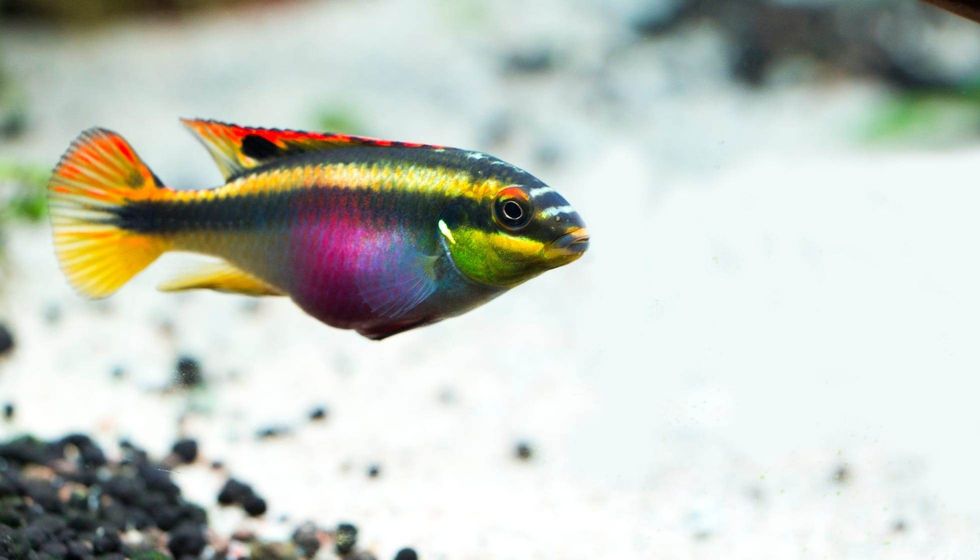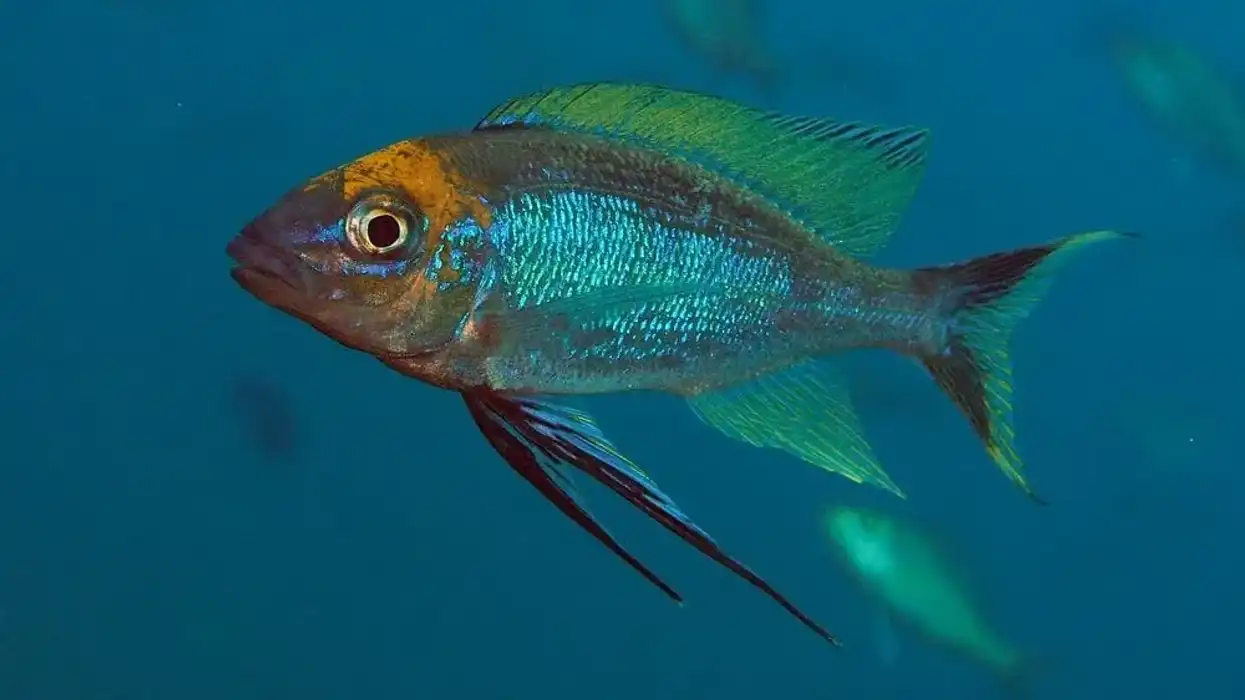The Rainbow Cichlids are popular fish known for their bright coloration, and are usually found in any fresh water body across locations such as Central and South America.
They are great fish to keep in a tank, and the Red Rainbow Cichlid size and color is a perfect complement to the range of fish in a tank. They love plants as their primary diet, and do not enjoy fast flowing water, they lack the hardness of their relatives.
This allows them to cut through water, engage in breeding often, and their bright coloration is usually enough to keep their predators at bay.
Outside of a home tank, they can be seen swimming in slow water lakes and rivers all over Central and South America. They engage in breeding almost all year round, and with a healthy diet, these fish, with their distinct coloration, can be the blue-orange star of any tank!
They are bred extensively, not that they need much help breeding. They are found in multiple colours, such as blue, orange, red, and more, which has earned this species its name.
Want to know more about their breeding and how they are bred? Maybe you want to learn about breeding your own fish, or about the plants they enjoy? Then look no further, and read on. Also check out the brain coral and milkfish to know more about this species.
Rainbow Cichlid Interesting Facts
What type of animal is a Rainbow Cichlid?
Rainbow Cichlid (Herotilapia multispinosa) is a type of fish.
What class of animal does a Rainbow Cichlid belong to?
The Rainbow Cichlid (Herotilapia multispinosa) breed belongs to the class of fish.
How many Rainbow Cichlids are there in the world?
About 1,650 species have been identified, making this tropical fish one of the biggest vertebrate families. The actual number of this fish is unknown, approximately varying between 2,000-3,000.
Where does a Rainbow Cichlid live?
In the wild, some species of Rainbow Cichlid (Herotilapia Multispinosa) fish live in the Ocean region. However, they live in freshwater body for the most part, and in a temperature controlled aquarium when in captivity.
What is a Rainbow Cichlid's habitat?
Rainbow Cichlids are native to the Pacific and the Atlantic slopes of Central America, in Honduras, Costa Rica and Nicaragua. Generally, these tropical fish are found in shallow to turbid water such as lakes and the weedy margins of streams.
They can also be found in small ponds which may be flooded periodically by nearby rivers. Rainbow Cichlids are usually peaceful by nature and are well-suited to be placed in a community tank. In a tropical water tank, they can be easily be kept with other catfish.
Who do Rainbow Cichlids live with?
Rainbow Cichlid (Herotilapia Multispinosa) is peaceful by nature and suitable to being kept in a community aquarium tank. They can be kept in a tropical aquarium tank along with certain livebearers, giant danios, tetras, plecostomus.
Pairs will generally get along fine. But sometimes keeping more than one pairs of these cichlids will usually result in fights. These are well socially developed species.
How long does a Rainbow Cichlid live?
Rainbow Cichlid (Herotilapia Multispinosa) fish have a lifespan of 7-9 years with proper and appropriate care in a tank.
How do they reproduce?
Rainbow Cichlids are pair-bonded substrate spawner fish and are easy to breed in a tank too. A pair choose an appropriate spawning place, mostly a piece of slate or smooth rock.
This will be defended usually by the male, against all other fish, especially other males Rainbow Cichlids. The female lays her eggs on the selected area in multiple lines, the male immediately following on each run, fertilizing them. Up to 1500 eggs may be laid if the fish are large and mature.
The eggs are closely guarded by females and will fan oxygenated water over eggs with her pelvic fins. while the males defend the outside premises of their territory.
The eggs should hatch within 48 hours depending on the temperature. Within a week the fry will become free-swimming. During this time, the parents' pair may move their young into other pre-dug spawning pits within their territory.
After free swimming, the fry should be fed finely powdered baby brine shrimp and fry foods. Usually, the parents care for the fry for around four weeks.
What is their conservation status?
IUCN Red List Status declares the Rainbow Cichlid (Herotilapia Multispinosa) as a Least Concern species.
Rainbow Cichlid Fun Facts
What do Rainbow Cichlids look like?

*Please note this image is of a Green terror fish that belongs to the same family as the Rainbow Cichlid. If you have an image of a Rainbow Cichlid, please let us know at hello@kidadl.com.
The background color of this tropical fish is shining golden to lemon-yellow and they have a magnificent horizontal black bar that appears from just behind its eyes towards the base of its caudal fins. It is tedious to differentiate between male and female Rainbow Cichlid (Herotilapia multispinosa).
Males tend to be longer and larger with pointed anal and dorsal fins. Females have a small ovipositor.
How cute are they?
The Rainbow Cichlid (Herotilapia Multispinosa) is a magnificent brightly colored Central American species that is rather small and peaceful for a cichlid. It has a superb disposition and vivid coloration as it matures. These fish looks superbly cute.
How do they communicate?
The Rainbow cichlid (Herotilapia multispinosa) is a socially organized fish and signal their social ranks through acoustic, chemical, and visual communication. The response to signaling may be different according to the specific species and environment.
How big is a Rainbow Cichlid?
Rainbow Cichlid adult size can reach up to 2–15 cm in length, but most adult's average length is around 7–8 cm. The average length of most Damselfish is about 5 cm. Rainbow Cichlid is much bigger than Damselfish.
How fast can a Rainbow Cichlid swim?
Fins of Rainbow child are soft and perfect for precise positions and easy movements in the water as opposed to fast swimming.
How much does a Rainbow Cichlid weigh?
The precise weight of Rainbow Peacock Cichlid is unknown till now.
What are their male and female names of the species?
There is not any specific name for the Rainbow Cichlid female or male.
What would you call a baby Rainbow Cichlid?
We can call a baby Rainbow African Cichlid fry, or wrigglers.
What do they eat?
The Rainbow Cichlid fish are omnivores. When they are in the wild, they mostly feed on flocculent detritus and food like diatoms, filamentous algae, and pure algae.
They also include smaller insects and other small fish in their diet. When they are in captivity, they can usually their main food is pellets or flakes. They are mostly eager eaters and also feeding on prepared foods like ocean plankton, tubifex, freeze-dried bloodworms, and floating food sticks.
Are they aggressive?
Rainbow Cichlids are not usually aggressive, especially when compared to other cichlids. These tropical fish can easily be placed along with other peaceful fish. They are quite easy to care for because of their calm nature. It is a peaceful fish typically, although slightly and rarely aggressive, except during the spawning period.
Would they make a good pet?
Rainbow Cichlid fish are usually beginner-friendly fish that are hardy for many tank environments and settings, plus they tend to breed well in captivity. Mostly they are fine with small tankmates.
Cichlids are some of the most beautiful fish in the world, But sometimes they can also be the most aggressive. These are peaceful fish that are territorial but rarely aggressive, except during spawning. It can conveniently be kept with different medium-sized cichlids such as Convicts, Parrots, and Firemouths.
Did you know...
The colors of Rainbow Cichlid can also change depending on their different mood, especially during the time of spawning, which is unusual in freshwater fish.
The truth about this fish is that African Cichlids do eat their fry. African Cichlids have a tendency to keep their young ones in their mouths to protect their fry, accidentally eating them.
Why is it called Rainbow Cichlid
Rainbow Cichlids are very colorful fish when in a suitable environment. These are popular because of their vibrant colors and on account of their manageable size and peaceful nature. They are able to change their color dramatically, depending on their specific mood or when in the spawning period.
Having your own Rainbow Cichlid
These fish are easily available at fish stores or online. They are not so expensive but have a moderate cost.
The size of the aquarium tank should be at least three feet in length for a pair of Rainbow Cichlid, and a larger aquarium tank will be needed if a group is being maintained.
Water should be filtered properly with a medium level of water flow. During dry weather, they can survive in high temperatures, however, it is advised to maintain these fish at a steady temperature between 22-28 degrees C in the aquarium tank.
Rainbow Cichlids require clean water, so it is necessary to change the water regularly. It is best to choose sand, as opposed to gravel for the bottom of the aquarium tank because they prefer a muddy substrate.
They can live alone or as a pair. As this fish is not so aggressive, it can also be kept with other pairs of Rainbow Cichlids, but the tank size should be larger.
Here at Kidadl, we have carefully created lots of interesting family-friendly animal facts for everyone to discover! Learn more about some other fish including convict cichlid, or peacock cichlid.
You can even occupy yourself at home by drawing one on our rainbow skink coloring pages.










